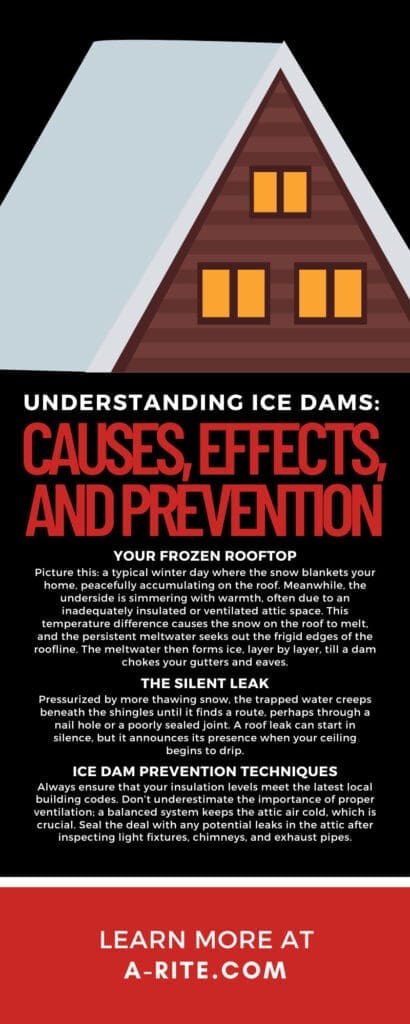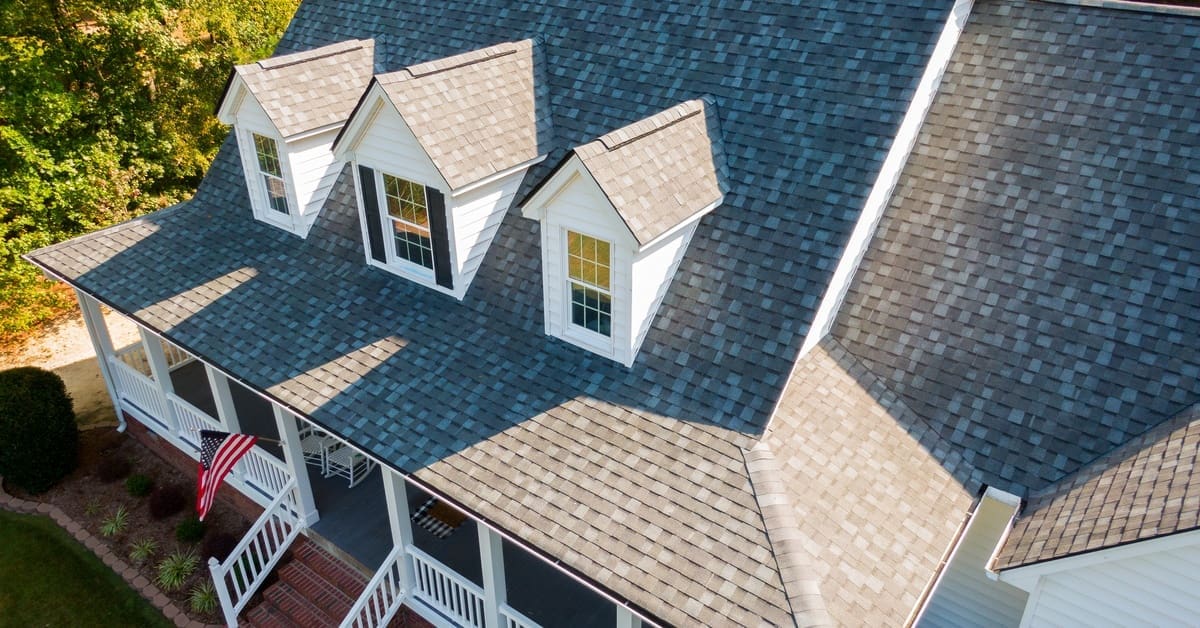The picturesque scene of icicles clinging to the edges of your roof can be dangerously deceptive. These are not merely wintery decorations but telltale signs of an impending threat to your home’s integrity. For homeowners in colder climates, the phenomenon of ice dams is a well-known concern that can lead to extensive damage if left unchecked.
Follow along as we explore ice dams to learn the causes, effects, and prevention of this dangerous house hazard.
How Ice Dams Take Shape
How do ice dams form? What causes them? Let’s learn!
Your Frozen Rooftop
Picture this: a typical winter day where the snow blankets your home, peacefully accumulating on the roof. Meanwhile, the underside is simmering with warmth, often due to an inadequately insulated or ventilated attic space. This temperature difference causes the snow on the roof to melt, and the persistent meltwater seeks out the frigid edges of the roofline. The meltwater then forms ice, layer by layer, till a dam chokes your gutters and eaves.
The Culprit
Wind and sun introduce a wild fluctuation of temperatures along the roof’s length, transforming the melting snow into unwanted ice barricades.
Factors at Play
Three primary factors invite these ice encroachments:
- Poor attic insulation
- Uneven roof temperatures from compromised insulation and sporadic sunny days
- Heavy or persistent snowfalls
The Shattering Effects of Ice Dams
When left undisturbed, ice dams act as cruel reservoirs that trap melted water on your roof, like prisoners condemned to the freezing slabs of shingles. With no outlet, this captive water has a singularly destructive mission—to penetrate your home’s defenses.
The Silent Leak
Pressurized by more thawing snow, the trapped water creeps beneath the shingles until it finds a route, perhaps through a nail hole or a poorly sealed joint. A roof leak can start in silence, but it announces its presence when your ceiling begins to drip.
The Indoor Battle
Water travels unseen and silently through attics and walls. It stains, warps, and sows the seeds of mold wherever it goes. By the time you notice the water spots on your ceiling, the war against ice dams has morphed into a costly, chaotic conflict.
The Alarming Costs
Ice dams aren’t just about occasional drips; they represent significant costs regarding structural damage, mold remediation, and compromised insulation. Ironically, their creation often results from the mechanisms designed to keep homeowners warm and energy-efficient.
Ice Dam Prevention Techniques
Prevention is your primary offensive strategy against ice dams. Good attic insulation is a thermal barrier that keeps the roof temperature stable and unsuitable for dam construction.
Always ensure that your insulation levels meet the latest local building codes. Don’t underestimate the importance of proper ventilation; a balanced system keeps the attic air cold, which is crucial. Seal the deal with any potential leaks in the attic after inspecting light fixtures, chimneys, and exhaust pipes.
The Frosty Perimeter
Maintaining a frigid but ice-free perimeter is your second line of defense.
- After significant snowfalls, use a roof rake to clear the first several feet of your roof, ensuring a pathway for meltwater to flow without obstruction.
- Create a chemical boundary on the roof by installing heating cables. Though this is not a permanent fix, it does help melt channels for water to escape in the short term.
Continual Prevention
Continuous vigilance is your ally. Regularly inspect your roof for signs of melted snow and ice accumulation. Addressing these signs can prevent the formation of the more formidable ice dams.
Additional Prevention Strategies
Beyond insulation, ventilation, and immediate removal methods, homeowners can implement several more strategies to prevent ice dam formation. These strategies are not just about dealing with ice after it forms but about stopping the conditions that lead to its formation in the first place.
Upgrade Your Roofing Material
Consider installing ice and water shield products. These rubberized membranes go under the shingles to create a waterproof barrier. This preventative measure is especially crucial at the roof’s edges and valleys, where ice dams commonly form.
Improve Gutter Health
Keep your gutters and downspouts clean and free of debris. A clogged gutter can impede water flow, encouraging the formation of ice dams. Installing gutter guards can be proactive in minimizing maintenance and ensuring that water flows away from your roof efficiently.
Regulate Indoor Heat Distribution
Avoid excessive heat in your attic. Check for air leaks from the living spaces below and seal them. Even simple measures, such as closing the attic hatch properly or insulating attic staircases, can make a difference in maintaining a cold attic.
Consider a Metal Roof
If you’re in a particularly high-risk area for ice dams and considering a new roof, metal roofs are practically impervious to ice dam damage. Snow and ice slide off more easily than from traditional shingle roofs, significantly reducing the risk of dam formation.
By incorporating these additional preventative measures into your winterizing routine, you can further bolster your home’s defense against ice dams’ costly and destructive effects. Regular inspection, maintenance, and strategic improvements can ensure your home remains a safe, warm refuge, even in the harshest winter conditions.
Dealing With the Ice Dam
When you have an ice dam, you want to take swift action to remove the hazard. Don’t delay.
Safe Removal Strategies
Do not go whacking at the formed ice dam. Hacking away with an ax or using sharp tools can damage your roof and gutters. Instead, use a blunt mallet or a tool specifically designed for this task. You can also carve a shallow channel in the ice to allow trapped water to escape.
The Professional Reinforcements
In most cases, it’s best to seek the aid of professionals. Roofing experts equipped with steamers can safely and effectively remove ice dams without further endangering your home. Call an ice dam removal company like A-Rite to safely remove the ice dam that formed.
Final Thoughts
Not every winter scene needs to be a disaster waiting to happen. Implementing good insulation, ventilation, and roof maintenance practices increases the chance that the only icicles you’ll need to manage are those forming on your gingerbread houses.
Understanding ice dam prevention, its effects, and its causes can help keep your home safe all winter. Don’t hesitate to call a local professional to keep your home and family secure from the winter elements.




